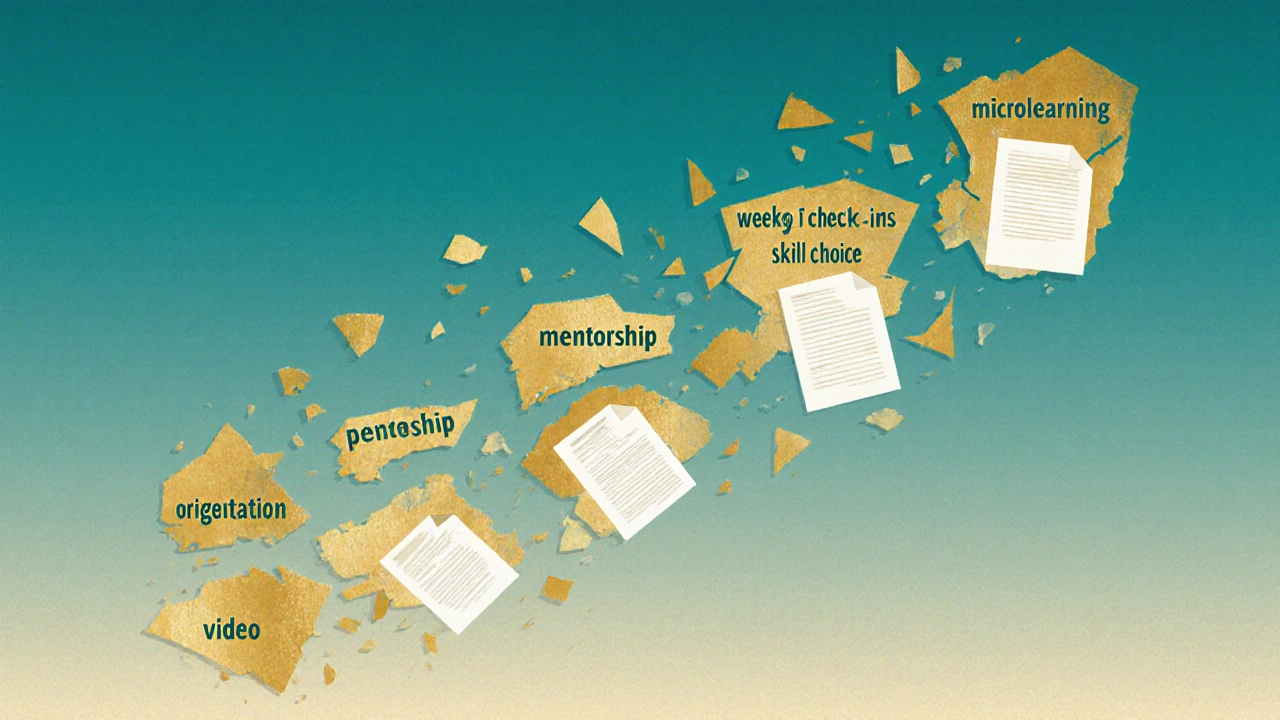Employee turnover isn’t just a number on a spreadsheet. It’s the cost of hiring, the lost knowledge, the dropped morale, and the time managers waste onboarding new people instead of doing their real work. In 2025, the average cost to replace a single employee in New Zealand is around $25,000 NZD-more if it’s a skilled role. But here’s the thing: most companies don’t fix turnover by raising pay. They fix it by fixing training.
Training That Actually Sticks Makes People Stay
Think about the last time you started a new job. You got a binder. Maybe a 30-minute video. Then you were thrown into your first task. If you were lucky, someone answered your questions. If you weren’t? You figured it out-or quit.
That’s not training. That’s trial by fire.
Companies with strong training programs don’t just hand out manuals. They build learning paths. They pair new hires with mentors. They give feedback loops. They let people practice before they’re expected to perform. And the results? A 2024 study by the New Zealand Institute of Workplace Learning found that businesses with structured onboarding and ongoing training saw 41% lower turnover in the first year compared to those with ad-hoc training.
It’s not about how long the training is. It’s about how well it connects to real work.
Case Study: Auckland Retail Chain Cut Turnover by 52%
In 2023, a mid-sized retail chain in Auckland had a 68% turnover rate among frontline staff. That meant half their team changed every year. Hiring and training costs were eating 18% of their annual revenue.
They didn’t raise wages. They didn’t offer bonuses. They redesigned training.
Here’s what they did:
- Replaced the 2-hour orientation with a 4-week structured onboarding program.
- Each new hire got a mentor-someone who’d been there 6+ months and was trained to coach, not just supervise.
- They built microlearning modules: 5-minute videos on handling returns, dealing with angry customers, using the POS system.
- Managers checked in weekly for the first month, not to audit, but to ask: “What’s confusing? What helped?”
- After 90 days, employees picked their next skill to learn-customer service, inventory, or team leadership.
One year later, turnover dropped to 32%. Retention among employees who completed the full program? 89%.
Why did it work? Because training became about growth, not compliance.
People Leave Managers, Not Jobs-Training Fixes That
Here’s a hard truth: most people don’t quit their jobs. They quit their managers.
And guess what? Managers who are poorly trained are the ones who micromanage, forget to give feedback, or don’t know how to handle conflict. Training isn’t just for new hires. It’s for everyone who leads.
Auckland-based logistics company, SpeedLink, noticed their team leads had the highest turnover. So they launched a “First-Time Leader” program. It wasn’t about PowerPoint slides. It was about role-playing tough conversations, learning how to give feedback that doesn’t feel like criticism, and setting up weekly 1:1s that actually mattered.
Within 8 months, the turnover rate among team leads dropped by 60%. And here’s the kicker: employee satisfaction scores on “my manager supports my growth” jumped from 42% to 81%.
Training doesn’t just teach skills. It teaches people how to care.

What Makes Training Effective? 4 Non-Negotiables
Not all training works. Here’s what separates the training that sticks from the training that gets ignored:
- It’s tied to real tasks-not theory. If you’re training someone to use a CRM, don’t show them a 20-minute demo. Let them use it to log their first call, with support.
- It’s spaced out-one big session doesn’t stick. Break it into chunks over weeks. People remember better when they return to it.
- It includes feedback-not just “good job.” Specific feedback like “You handled that complaint by acknowledging their frustration first-that’s exactly what we want” changes behavior.
- It gives choice-let employees pick what they want to learn next. Autonomy increases engagement. People stay where they feel they’re growing.
These aren’t nice-to-haves. They’re the baseline for retention.
What Happens When Training Is an Afterthought?
Take a call center in Hamilton that skipped formal training. New hires watched a video, got a cheat sheet, and started taking calls. Within three months, 70% had left. Why?
- They didn’t know how to handle escalations.
- No one checked in on them.
- They felt invisible.
Turnover wasn’t about pay. It was about feeling unprepared and unsupported.
Companies that treat training like a checkbox are paying for it in turnover. The real cost isn’t the LMS license or the trainer’s fee. It’s the lost productivity, the damaged customer experience, and the culture of burnout.

Training Is an Investment-Not a Cost
Some leaders still see training as an expense. They think, “Why spend money when we can just hire someone who already knows how to do it?”
But here’s the math:
- Hiring a new employee costs 1.5x their annual salary on average.
- It takes 6-8 months for a new hire to reach full productivity.
- Employees who feel well-trained are 3x more likely to stay 5+ years.
Investing in training doesn’t just reduce turnover. It builds a team that knows your systems, your values, and your customers better than any outsider ever could.
Companies that train well don’t just keep people. They grow leaders from within. They build loyalty. They create a reputation as a place where people don’t just work-they develop.
Where to Start If You’re Behind
If your training program feels broken, you don’t need a complete overhaul. Start small:
- Interview 5 people who quit in the last year. Ask: “What would have made you stay?” More than half will say, “I didn’t feel like I knew what I was doing.”
- Pick one role with high turnover. Redesign its onboarding. Make it 4 weeks long. Add a mentor. Add weekly check-ins.
- Track retention for that group for 6 months. Compare it to the old way.
- If it works, scale it.
You don’t need a fancy platform. You need consistency. You need care.
Training isn’t about filling time. It’s about building trust.
Does better training really reduce turnover, or is this just common sense?
Yes, it’s backed by data. A 2024 study from the New Zealand Institute of Workplace Learning showed companies with structured training programs had 41% lower turnover in the first year. Companies that combined onboarding, mentorship, and ongoing skill development saw retention rates above 80% after one year. This isn’t theory-it’s measurable.
What’s the cheapest way to improve training without spending a lot?
Start with mentorship. Pair new hires with experienced team members who’ve been there over six months. Give those mentors a 30-minute training on how to coach, not just supervise. No software needed. No budget required. Just time and intention. One Auckland retail chain cut turnover by half using just this one change.
Should training be mandatory, or should employees choose what to learn?
Core training-like safety, compliance, or systems use-should be mandatory. But beyond that, give people choice. Let them pick their next skill to develop: customer service, time management, leadership. Autonomy increases motivation. When people feel they’re growing in a direction they care about, they stay longer.
How long should training last before we expect results?
Don’t measure training by hours. Measure it by retention. Give new hires 90 days to settle in. Track who stays past that point. Companies that track retention over 6-12 months see the clearest results. Quick fixes don’t work. Consistent support does.
Is training only important for new hires?
No. In fact, the biggest turnover risk is among employees who’ve been there 1-3 years. They’ve learned the basics, but no one’s shown them the next step. Ongoing training-like leadership programs, advanced skills, or cross-training-keeps people engaged. People stay when they see a future, not just a job.
Final Thought: Training Is the Quiet Retention Tool No One Talks About
Most companies chase retention with perks: free lunches, flexible hours, gym memberships. Those help. But they’re bandaids. The real fix is training-consistent, thoughtful, personalized training that says: “We believe in you enough to invest in your growth.”
That’s the kind of culture where people don’t just stay. They thrive.


Comments
Jeff Napier
Training fixes turnover? LOL. You think people stay because of mentorship? Nah. They stay because they’re scared to leave. The real reason companies push training is to lock employees in with institutional knowledge. Once you know all the secret workarounds for the POS system, you’re trapped. This isn’t about growth-it’s about control disguised as care.
Sibusiso Ernest Masilela
How quaint. You treat training like some sacred ritual while ignoring the fundamental truth: people leave because they’re underpaid and overworked. Your ‘structured onboarding’ is a placebo for leaders too lazy to pay a living wage. 89% retention? Cute. But tell me-did those employees get a raise? Or just more microlearning videos while their rent doubled?
Taylor Hayes
I’ve seen this work firsthand. I used to manage a team where new hires were thrown into customer service with zero support. People burned out in weeks. We started pairing them with mentors-just 15 minutes a day, no agenda, just ‘how’s it going?’-and within 3 months, retention jumped. It’s not about the program. It’s about making someone feel seen. That’s the real ROI.
Sanjay Mittal
From India, I can confirm-this works. In our call center, we had 70% attrition. We started with peer shadowing: new hires spend 2 days with a senior rep, then co-handle calls. No formal training, just observation + feedback. Turnover dropped to 28% in 6 months. You don’t need fancy LMS. You need someone who’s willing to slow down and teach.
Mike Zhong
You’re romanticizing training like it’s a spiritual awakening. The system doesn’t care if you feel ‘seen.’ It cares about output. Training is just another efficiency hack-another way to extract more value from labor under the guise of ‘growth.’ If you really believed in development, you’d give employees equity, not more modules. This isn’t care. It’s capitalism with a smiley face.
Jamie Roman
One thing I’ve learned over 15 years in HR: people don’t leave because of the job. They leave because they feel like they’re disappearing. When you skip the check-ins, skip the mentorship, skip the ‘what do you need?’-you’re not just failing at training. You’re failing at humanity. The Auckland retail case? That’s not a case study. That’s basic decency. And it’s shocking that we have to treat it like some revolutionary idea.
I’ve watched teams turn around with nothing more than managers who show up, listen, and say ‘I got you.’ No budget. No software. Just presence. That’s the real training.
Salomi Cummingham
I cried reading this. Not because I’m emotional-though I am-but because I’ve been the person who quit because I didn’t know how to use the damn printer. No one asked. No one cared. I felt like a ghost in a fluorescent-lit hell. This isn’t just about retention-it’s about dignity. When you give someone a mentor, you’re saying: ‘You matter enough for someone to invest time in you.’ That’s rare. That’s powerful. And yes-it changes lives.
My sister worked at a grocery chain that did exactly this. She stayed for 7 years. Said it was the first time she ever felt like she belonged. Training didn’t teach her how to scan items. It taught her she wasn’t alone.
Johnathan Rhyne
Training is not a magic wand-it’s a tool. And if you’re using it like a feather duster, you’re doing it wrong. But here’s the kicker: the real problem isn’t training. It’s the fact that 90% of managers were never trained to manage. You can’t fix turnover by training employees if the people they report to are emotional landmines with Excel sheets. Fix the managers first. Then the training works. Otherwise, you’re just polishing the coffin.
Kendall Storey
Let’s cut the fluff. Training doesn’t reduce turnover. Engagement does. And engagement comes from autonomy, mastery, and purpose. Your 4 non-negotiables? That’s just self-determination theory dressed in HR jargon. But hey-if your org needs a checklist to stop bleeding talent, fine. Just don’t call it ‘care.’ Call it ‘strategic retention.’ And maybe, just maybe, pay people enough to not need it.
Ashton Strong
Thank you for this comprehensive and deeply insightful analysis. The empirical data presented-particularly the 41% reduction in turnover and the 89% retention rate among program completers-provides compelling, evidence-based validation of what organizational psychology has long posited: sustained investment in human capital yields measurable, long-term returns. This is not merely a best practice; it is a strategic imperative for sustainable organizational health. I commend the authors for framing training not as an operational cost, but as a foundational pillar of cultural integrity and employee dignity.